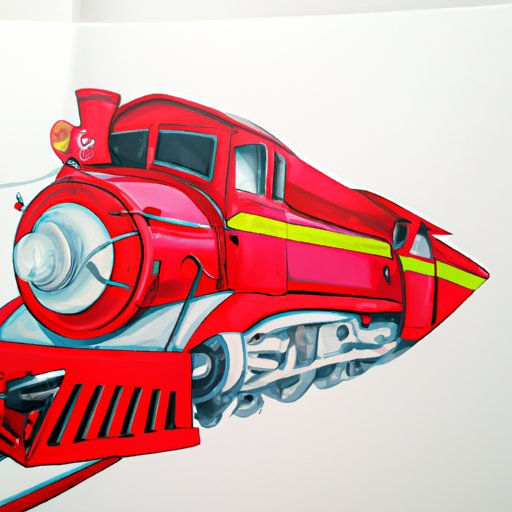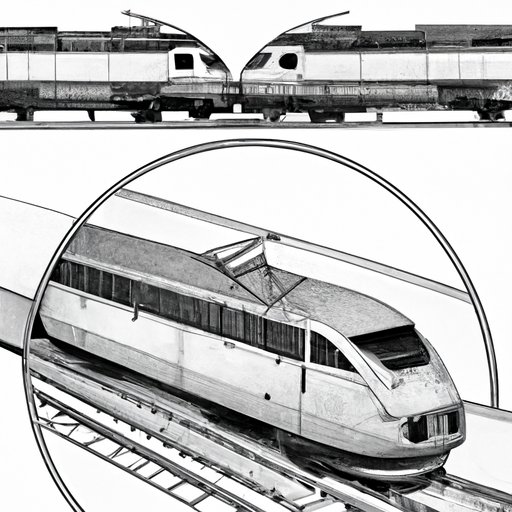
Introduction
Trains have been a popular subject in art for centuries. Learning how to draw a train can be a fun and challenging experience for artists of all skill levels. Whether you want to create a realistic or cartoon drawing, understanding the techniques and styles used to draw trains can help you improve your overall art skills. In this article, we will explore the step-by-step process of drawing a realistic train, as well as techniques and tips for creating your own unique train drawings.
10 Steps to Draw a Realistic Train: A Beginner’s Guide
For beginner artists, drawing a realistic train can be a daunting task. Here are 10 steps to help you get started:
- Start with basic shapes: Use simple shapes like circles, rectangles, and triangles to create the basic outline of the train.
- Add detail to the train body: Use smaller shapes and lines to add details to the train body.
- Draw the wheels and rails: Add detail to the wheels and rails, making sure they are symmetrical and proportional to the train body.
- Draw the front of the train and the smokestack: Sketch the front of the train, making sure it is in proportion to the rest of the train body. Add the smokestack coming out of the top of the train.
- Add windows and doors: Draw the windows and doors on the train body, taking into account the perspective of the drawing.
- Add shading and texture: Start shading the train body and add texture to the wheels and rails.
- Refine the details: Go back and refine the details of the train body, adding shading and texture as needed.
- Color (optional): If desired, color the train using colored pencils, markers or other mediums.
- Final touches: Add any final touches, such as highlights, to complete the drawing.
- Show off your drawing: Share your train drawing with others and seek feedback to improve your skills.
Remember, drawing a realistic train takes time and practice. Don’t be discouraged if your drawing doesn’t look perfect the first time.
From Sketch to Steam Engine: Mastering Train Drawing Techniques
One of the most important aspects of drawing a train is understanding the techniques used to create it. Here are some of the most common techniques:
- Perspective: Use perspective to create the illusion of depth and make the train look 3D.
- Shading: Use shading to add dimension to the train and make it look more realistic.
- Texture: Add texture to the train, such as rust and metal, to make it look more authentic.
- Proportion: Ensure each part of the train is proportional to the others and that the overall drawing is proportional to reality.
- Color: Use color to add vibrancy and depth to your train drawing.
- Drafting: Use drafting tools like compasses and protractors for precise lines and details.
Perhaps the most important technique in train drawing is practice. Keep drawing trains to hone your skills and perfect your technique.
All Aboard: Tips and Tricks to Draw Your Perfect Train
Here are some additional tips and tricks to keep in mind when drawing your perfect train:
- Choose your medium carefully: Depending on your skill level, certain mediums may be easier to use than others. Experiment with different mediums to find the one that works best for you.
- Study real trains: Observe and sketch real trains to gain a better understanding of their anatomy and detail.
- Be patient: Train drawing can be a complex and time-consuming process. Be patient with yourself and your drawing.
- Use reference photos: Use reference photos to ensure your train is accurate and authentic.
- Practice different train poses: Draw trains in different positions to improve your skills and challenge yourself.
- Try different perspectives: Experiment with different perspectives, such as a bird’s eye view or a side view of the train.
Remember, train drawing is a skill that requires practice and patience to perfect.
Choo Choo! How to Draw a Cartoon Train in 5 Easy Steps
If you’re looking for a more lighthearted train drawing, creating a cartoon train may be the way to go. Here’s how:
- Start with basic shapes: As with realistic train drawing, start with basic shapes to create the outline of the train.
- Add eyes and a smile: Draw the eyes and a smile on the front of the train to give it a friendly, cartoonish appearance.
- Add a chimney and wheels: Draw a chimney coming out of the top of the train and wheels at the bottom.
- Detail the train: Add any additional details to the train, such as windows or lettering.
- Color: Color the cartoon train to bring it to life.
Creating a cartoon train is a fun and easy way to practice your train drawing skills while creating a whimsical and fun piece of art.
Train Anatomy: Understanding the Components of Train Drawing
When drawing a train, it’s important to understand the different parts that make up the train to create a realistic and accurate drawing. Here are a few key components you should know:
- Train body: The main part of the train that carries passengers and cargo.
- Engine: The part of the train that provides the power to move the train.
- Smokestack: A tall chimney on top of the train that emits smoke or exhaust.
- Boiler: The part of the engine responsible for heating water to produce steam.
- Tender: The car behind the engine that carries coal and water for the engine.
- Wheel Assembly: The group of wheels on the train that connect it to the rails.
- Drawbar: The metal bar that connects the cars of the train together.
Understanding the anatomy of a train is important in creating realistic and accurate drawings of trains.

Drawing Inspiration: Famous Train Artworks and What We Can Learn From Them
There are countless famous train artworks that have inspired artists for generations. Here are a few examples:
- The Persistence of Memory by Salvador Dali: A surrealist painting featuring a surrealistic train.
- Train in the Snow by Claude Monet: An impressionist painting featuring a train in the snow.
- The Great Train Robbery by Winsor McCay: A cartoon featuring a train robbery.
Each of these artworks showcases a different style and technique used in train drawing. Analyzing famous train artworks can help you gain insight into the techniques and styles used in train drawing and inspire you to try new techniques in your own work.
Taking Your Train Drawing to the Next Level: Experimental Techniques and Unconventional Styles
Once you’ve mastered the basics of train drawing, consider experimenting with different techniques and styles to create your own unique train drawings. Here are a few ideas to get you started:
- Mixed media: Incorporate different mediums, such as watercolor or pastels, into your train drawing.
- Cubism: Create a train drawing using the cubist style.
- Pop Art: Create a train drawing in the style of pop art.
- Minimalism: Create a minimalist train drawing with simple lines and shapes.
- Abstract: Create an abstract train drawing with geometric shapes and bold colors.
Experimenting with different techniques and styles can help you find your own unique voice in train drawing.
Conclusion
Learning how to draw a train can be a fun and rewarding experience for artists of all skill levels. Whether you’re drawing a realistic train or a cartoon train, understanding the different techniques and styles used in train drawing can help you create your own unique pieces of art. Remember to be patient and practice often, and soon you’ll be creating train drawings that are truly exceptional. So go ahead, grab your pen or pencil, and start drawing!
Don’t forget to share your train drawings with others and seek feedback to continue improving your skills.




